In this post, I’ll talk more about customer satisfaction, what it is, why it’s important, how to measure it, and the benefits that an investment in customer satisfaction will bring to your business.
Table of Contents
What Is Customer Satisfaction?
Customer satisfaction (CSAT) is a metric used to quantify the degree to which a customer is happy with a product, service, or experience related to your business. This metric is calculated via customer satisfaction surveys that ask how a customer feels about their experience, with answers ranging between 'highly unsatisfied' and 'highly satisfied.'
Customer satisfaction takes into account various facets of the customer experience, such as:
- The availability of your products.
- The purchasing process.
- The steps after purchase.
- The responsiveness of your team when resolving issues.
Let’s look at Trader Joe’s as an example. One of my favorite things about shopping at Trader Joe‘s is its generous return policy. Customers can return any product if they’re unhappy, even if it's already been opened and consumed.
This policy is undoubtedly expensive for Trader Joe's, but customer satisfaction programs like these pay off in the long run and earn them more revenue.
Customer satisfaction ultimately reflects how a customer feels about interacting with your brand, and businesses quantify these feelings with customer satisfaction surveys. These responses can give you a picture of customer loyalty and predict customer referral likelihood.
It all might feel nebulous, especially if you’re not used to sending out CSAT surveys. To begin fostering customer satisfaction, you should start with the basics: a customer support strategy.
The good news is you don’t have to create it from scratch. Use the template below to get started.
Featured Resource: Customer Support Strategy Template
This customer support strategy template will help you outline critical information about your company's customer experience. You’ll have space to create a customer support vision, a support process, and a list of goals and metrics to measure success. The template includes instructions for filling out each section.
I also like that you’re able to create a support strategy that helps you methodically improve customer satisfaction.
Why Is Customer Satisfaction Important?
Customer satisfaction is important because it helps you solve problems, prevent churn, and identify happy customers that can become your advocates and evangelists. It’s an essential step in the process of building customer loyalty, creating customer delight, and generating positive word-of-mouth.
If you don't measure customer satisfaction, you can‘t identify unsatisfied customers that could churn or leave negative customer reviews. You also can’t identify happy customers you could activate as evangelists. Finally, you can't predict, prevent, and proactively plan to prevent customer churn without metrics to analyze.
Featured Resource: Customer Service Metrics Calculator
So, avoiding common CSAT survey mistakes is essential. Still not convinced, or think you can wing it? Below, I’ll discuss the benefits of understanding and increasing customer satisfaction.
Benefits of Customer Satisfaction
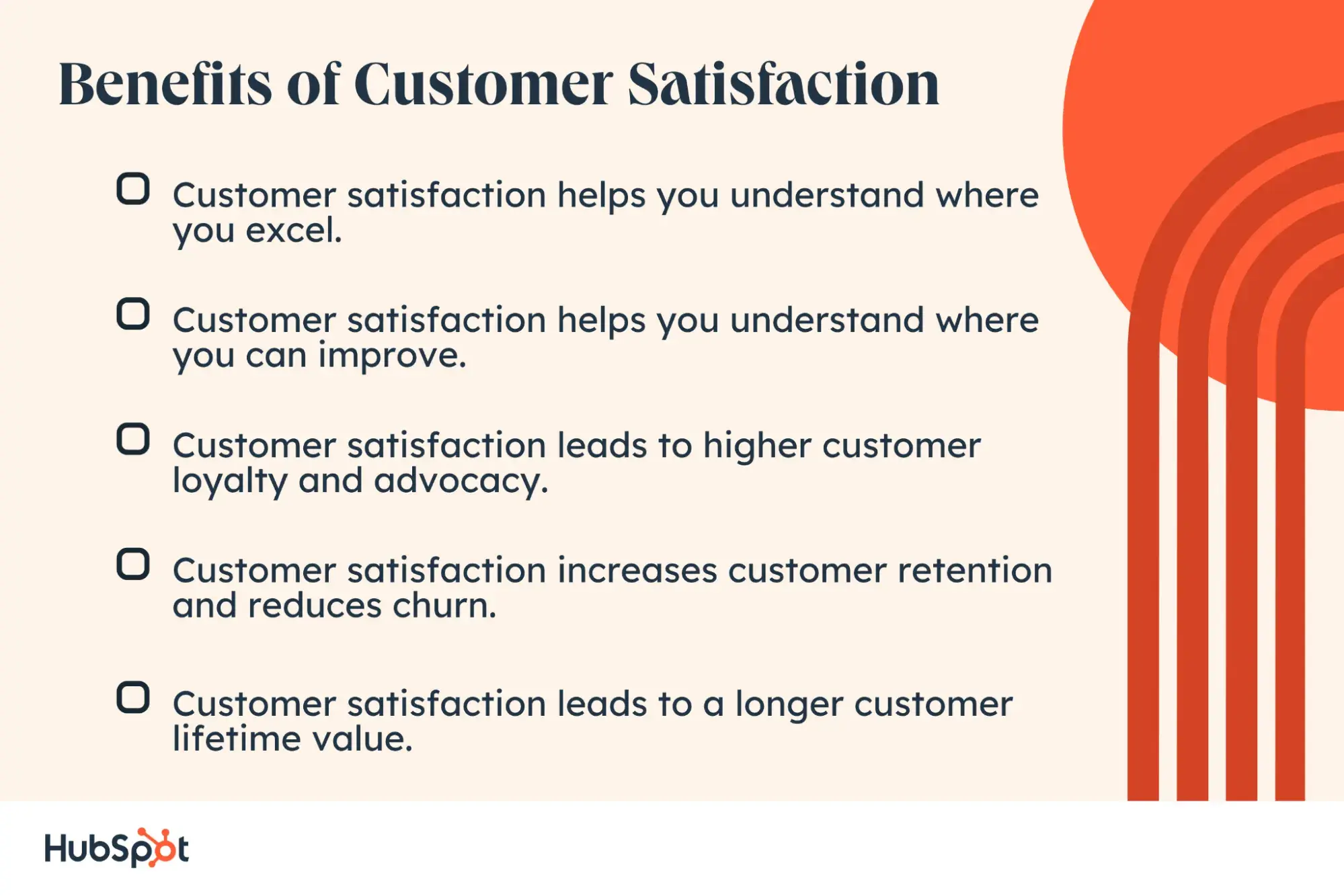
1. Customer satisfaction helps you understand where you excel.
Tracking and measuring customer satisfaction helps you identify what your business excels at so you can continue to build on those strengths. However, you must conduct customer satisfaction surveys to discover those valuable details.
Growing companies prioritize customer success, and an essential way to identify satisfied customers is through customer feedback. Customer feedback can come in the form of survey responses or conversations with your customer-facing teams.
As a support representative, I was often the first to receive customer perspectives about new features and updates. Generally, I had a pulse on what aspects of the customer experience were going well. So, don’t forget to loop in your service teams when gathering feedback data.
Armed with crucial customer feedback information, you can focus on replicating positive experiences and reaping the benefits:
- Retaining an existing customer is more cost-effective than acquiring a new one.
- Repeat and loyal customers spend 31% more and are 50% more likely to try new products.
- 66% of salespeople report that the highest quality leads come from existing customers and referrals, contributing to 5-15% of new customer acquisitions.
2. Customer satisfaction helps you understand where you can improve.
Identifying your shortcomings is necessary for improvement. This has been true for me as a support rep, as a professional bassist, and in general for life. The same thing goes for business. Your customer satisfaction surveys will illuminate where you are falling short, which is essential for improving the customer experience.
Negative feedback is tough, but my professional experience as a support rep and musician has taught me much about learning from mistakes and integrating feedback. Here are my takeaways.
Get comfortable with the uncomfortable.
Hearing negative feedback can be difficult, but it’s the secret ingredient for growth. Instead of shying away from negative feedback, think of it like going to the gym. Your feedback integration muscle will get stronger over time, and eventually, you’ll crave that bittersweet fuel for improvement.
Act quickly and close the feedback loop.
Once you’ve received actionable feedback, make appropriate changes as swiftly as possible. Then, loop back with the customer to let them know their input has led to improvements.
One of the highlights of my job in support was customers’ reactions when they realized we finally released an update or feature they had been asking for. It’s a gratifying experience for customers to know their voice is being heard and acted upon.
Prevention is best.
Even better than responding to negative feedback is getting ahead of it in the first place. As a support rep, I would proactively recommend features or workarounds that I knew customers would benefit from in the future. They always appreciated that I was looking out for them.
The same concept applies at a higher level when designing products and services. The key is having an intimate understanding of customer needs and challenges.
HubSpot’s Service Analytics tool makes it easy to uncover critical insights into your customers, like built-in CSAT reports, to gain the understanding you need to continuously deliver on customer expectations.
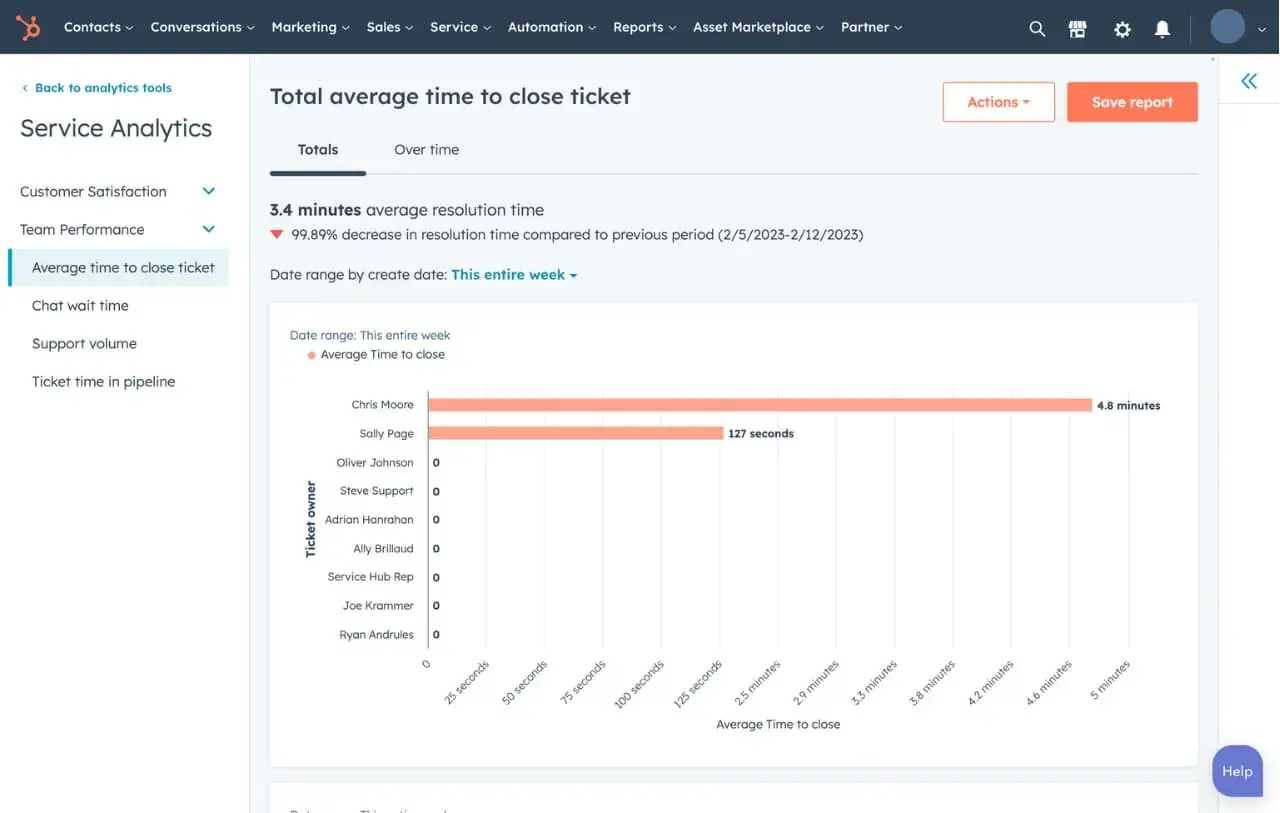
Get Started with Service Analytics
3. Customer satisfaction leads to higher customer loyalty and advocacy.
As a support rep, I witnessed firsthand the power of customer satisfaction in building brand loyalty. Happy customers are loyal customers. Those who have had positive experiences report being 94% more likely to purchase again.
Satisfied customers are also likely to become brand advocates, an invaluable extension of your marketing team. They generate leads through word-of-mouth marketing and online recommendations. I remember helping out a customer who was so thrilled with her service that she wrote a lengthy, positive LinkedIn post. That was a good day.
Customers who spread the word about your brand are precious. You should take action to support them and incentivize them to continue advocating. You can create customer advocacy programs for these customers and encourage them to advertise on your business’s behalf.
Customer advocacy programs reward customers for referring your business to potential leads. Customers are given incentives to join the program and receive gifts or offers in exchange for reviews and testimonials. This creates a mutually beneficial relationship that rewards your best customers and keeps them loyal.
4. Customer satisfaction increases customer retention and reduces churn.
Unsurprisingly, the happier your customers are, the better your customer retention will be. Satisfied customers have no incentive to explore the competition as long as you continue to meet their needs. On the other hand, unhappy customers will have plenty of reasons to chur. It'll be up to your team to convince them otherwise.
Measuring CSAT allows you to analyze customer needs and create personalized offers for churn risks. Since only one in five customers would forgive a bad experience at a company, you may only get one opportunity to stop someone from churning. Customer satisfaction data empowers you to act strategically according to customers’ perceived interactions with your brand.
I’ve worked with frustrated customers who threatened to churn on more than one occasion. It’s scary to take ownership of retaining their business, but I’ve found that honesty, responsibility, and authenticity go a long way in defusing situations.
In support, we had a saying: “The buck stops here.” That meant we wouldn’t pass the responsibility along to someone else when the going got tough. Customers appreciated the honest approach, feeling genuinely heard and valued during challenging interactions. The result? Higher satisfaction and reduced churn.
5. Customer satisfaction leads to a longer customer lifetime value.
Customer lifetime value (CLV) represents the total profit you can expect from a single customer throughout their relationship with your business. Satisfied customers will likely remain loyal, making repeat purchases and contributing to a high CLV.
In contrast, unhappy customers are unlikely to return following a negative experience, which results in low CLV and missed revenue opportunities.
It pays to have satisfied customers. Customer satisfaction is crucial for improving service metrics and ensuring your company delivers the best experience possible. But how does it impact other teams?
Let’s take a look.
Customer Satisfaction in Marketing & Sales
Customer satisfaction is often associated with customer service and support teams. However, its impact extends beyond and influences all aspects of your business.
1. Customer satisfaction helps you forecast and work proactively.
Without CSAT and similar customer success metrics, customer success teams find it challenging to plan and inform other teams about the state of their customer base.
These metrics are invaluable across your whole organization. They give sales teams the information to improve customer interactions, enable product teams to integrate customer feedback to enhance product offerings, and empower marketing to craft a refined experience for the entire customer lifecycle.
Leaders need data and trends to forecast team performance over the next month, quarter, and year and adapt strategy if necessary.
When I worked as a support rep at HubSpot, customer satisfaction data was crucial for support management in making staffing decisions. For instance, we identified that customers were dissatisfied with the wait times in the phone support queue. We would then reallocate reps from other channels to reduce wait times and improve overall satisfaction.
2. Customer satisfaction drives your inbound methodology.
Customer satisfaction doesn’t just measure the quality of your service. It's the engine that powers your inbound methodology. It drives optimization across departments and helps to improve the customer experience overall.
Customer satisfaction data enables a positive feedback loop, allowing you to continually iterate and improve your offerings, which improves the customer experience and drives satisfaction even higher. You can visualize the process using the flywheel model below:
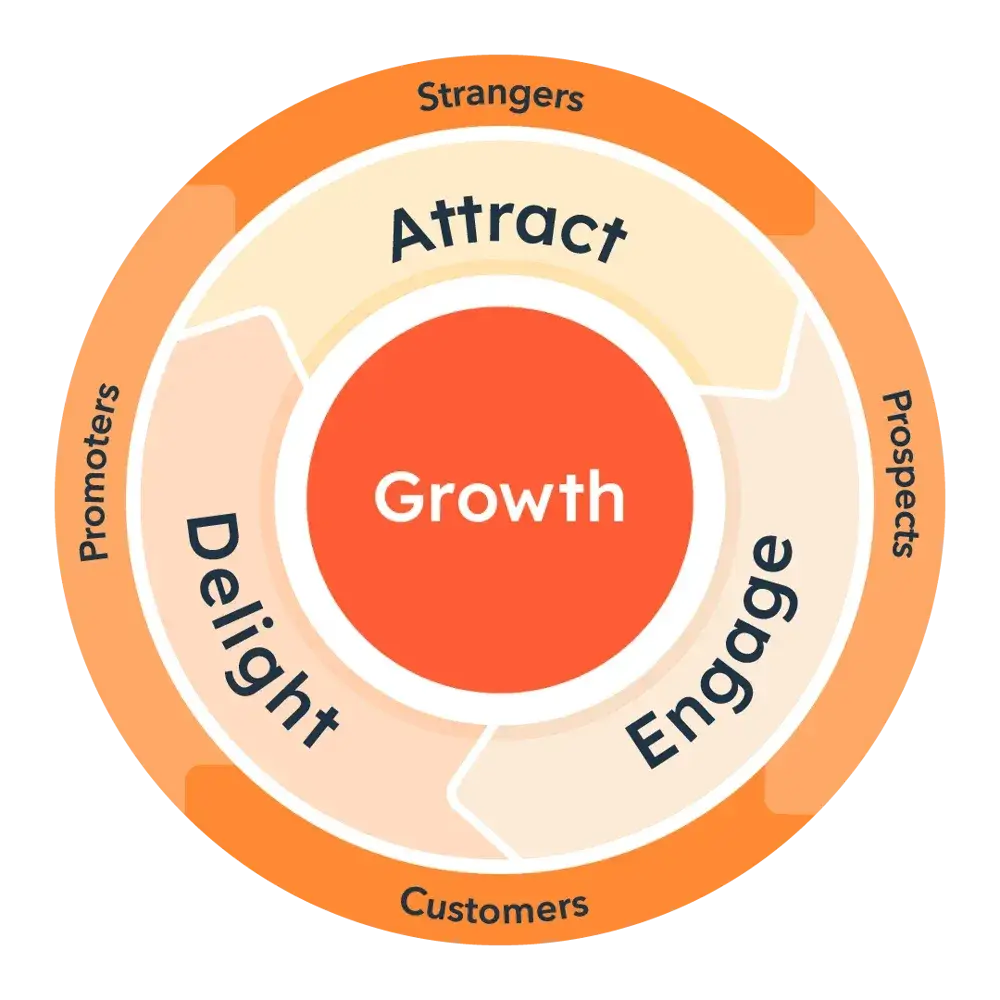
Marketing, sales, and product development teams use customer satisfaction data to guide their strategies and customer interactions. Businesses with excellent customer satisfaction can easily attract and engage with customers because they've proven they can provide a delightful brand experience.
If your company wants to adopt the inbound methodology, you must integrate customer satisfaction into every function you perform.
3. Customer satisfaction helps marketers attract new leads.
Consumers inherently trust their peers more than marketing information. This is a psychological phenomenon called social proof, which dictates that humans will naturally look to the behavior of others to validate their choice in a given situation. Essentially, if others are doing it, I should be doing it, too.
Cultivating social proof for your brand is reliant on customer satisfaction. If you offer a great product and keep your customers happy, others will catch on and want to be involved. Customer reviews are a potent form of social proof in business that most consumers will consult before purchasing.
No matter what I’m shopping for, customer reviews are the first thing I check. Even one negative review is enough to make me shy away from a purchase. I’m not the only review-conscious customer out there — here are a few stats:
- 90% of people consult reviews before making a purchase.
- User-generated content, including reviews, is 6.6 times more impactful than branded content.
- 78% of people trust online reviews as much as a recommendation from friends or family.
Customer testimonials are influential in attracting new leads, and it all starts with satisfying your customers so thoroughly that they are excited to share their experience with your brand. You should also consider incentivizing customers to leave reviews with discounts or small gifts.
4. Customer satisfaction is a selling point for marketing and sales teams.
Customer satisfaction is a powerful asset for marketing and sales teams. Customers are willing to pay for a product known to be excellent, especially if other consumers can validate that via testimonials.
If your customer satisfaction is superb, your marketing team should make it known in their communications. Your sales team should also highlight this during their pitches to leads.
Additionally, CSAT helps sales teams understand customer expectations. They can analyze customer reviews to see which parts of your product or service they should emphasize.
I knew a HubSpot sales rep who loved chatting with the support team. From her conversations with us, she knew which features customers commonly praised. She used that information as a focal point in her pitches, resulting in a 15% improvement in her close rate in just one quarter.
5. Customer satisfaction guides product updates.
Negative customer feedback is the canary in the coal mine when products or services need some attention.
When I worked in support, we had a close relationship with the product team. We would inform them about any bugs or unexpected behavior. If we noticed an uptick in customer frustration regarding a particular feature, we’d immediately bring it up to the product team.
This feedback loop is particularly important for SaaS businesses that regularly update their software. By monitoring customer satisfaction, development teams can correct costly product roadblocks that may lead to churn.
Are Your Customers Satisfied? How to Tell
Customer support is often the most frequent touchpoint between companies and customers. As a HubSpot support rep myself, I spoke to over a hundred customers per week. The easiest way to tell if a customer is satisfied is by talking to them.
Happy customers usually aren’t shy about letting you know they are pleased, especially after a positive service interaction.
However, you can’t just rely on word of mouth from your support team to measure customer success. There are plenty of other signs that show your customers are happy and healthy.
1. They Tell You
As I mentioned above, satisfied customers won’t hesitate to show you their love for your brand, but sometimes, you need to ask them. Satisfied customers will provide positive feedback directly to support and account management teams through surveys, social media, and other forms of direct communication.
As a support rep, I casually asked customers how they enjoyed a new feature or how their business was doing. While formal customer satisfaction surveys are always appropriate, I’ve found success in simply allowing customers to speak freely about their experiences.
I’m not one to fill out a customer satisfaction survey with overwhelming enthusiasm and detail. I think this goes for most people. However, given the opportunity to speak about my experiences with a product, I’ll spill the beans. So, if you’re wondering how customers feel, just ask them!
2. They Keep Coming Back
Customers are shy sometimes. They might not shout from the rooftops about their love for your brand, but that doesn’t mean they don’t like you. Actions speak louder than words, after all.
If your customers keep returning and making repeat purchases, they are likely satisfied.
Take me for example. I won’t go around bragging about my love for McDonald’s, filling out surveys. But for me, no road trip is complete without at least a large fry.
3. They Stick Around
Satisfied customers aren’t jumping ship.
Your customer retention and churn rates are crucial customer satisfaction metrics that show the rate at which customers are sticking with your brand or leaving. Needless to say, you want to maximize retention and minimize churn.
Our 2024 State of Customer Service Report shows that 53% of CRM leaders reported using HubSpot reduced customer churn.
Typical churn and retention rates vary by industry, but generally, a low rate of customers leaving your business indicates high customer satisfaction.
4. They Tell Other People About You
Satisfied customers are more likely to recommend your business to others.
According to the 2023 Nielsen Annual Marketing Report, 92% of consumers trust recommendations from friends and family over any other type of advertising.
A high rate of customer referrals indicates high customer satisfaction, which indicates a high level of dollars in your bank account. Woohoo! But in all seriousness, if your customers go out of their way to tell their friends about your company, you can rest assured that they are satisfied.
As I mentioned previously, I was a customer support representative at HubSpot. Now, I’m a writer (clearly) and a professional bassist in a touring band. In my experience, our best and most satisfied fans are the ones who tell their friends about us. They even post about us on social media. These superfans are no different from delighted customers who advocate for your brand.
Customers like that are precious, and you should consistently strive to make them understand your appreciation for them.
5. They Engage With You
Satisfied customers tend to engage more with your brand online, whether that is through social media interactions or loyalty programs.
Social media engagement is among the most significant indicators of satisfied customers and brand advocates. If you receive plenty of comments from customers on your IG posts, reposts of your TikToks, and replies on X, they are likely pleased with you.
According to our 2024 Social Media Marketing Report, 64% of consumers expect real-time responses on social media, and 78% say that a brand’s social media response time impacts their overall satisfaction. Accordingly, maintaining customer engagement on social media is crucial to customer satisfaction.
When I worked at HubSpot, I was a member of the Twitter support team (it was a while ago, pre-X). Supporting customers via social media is a fantastic opportunity to transform frustrated customers into satisfied ones. Customers often take to social media to quickly vent about an issue with a product or service. If you can quickly swoop in to unexpectedly solve their problem, you’ll likely turn a regular customer into a loyal one.
What Customer Satisfaction Looks Like
Customer satisfaction isn’t just a responsibility that falls on support and other teams in direct contact with customers. Optimizing for customer satisfaction is an organization-wide endeavor that permeates all departments through process and culture.
Here are some ways to bring customer satisfaction to the forefront of your company.
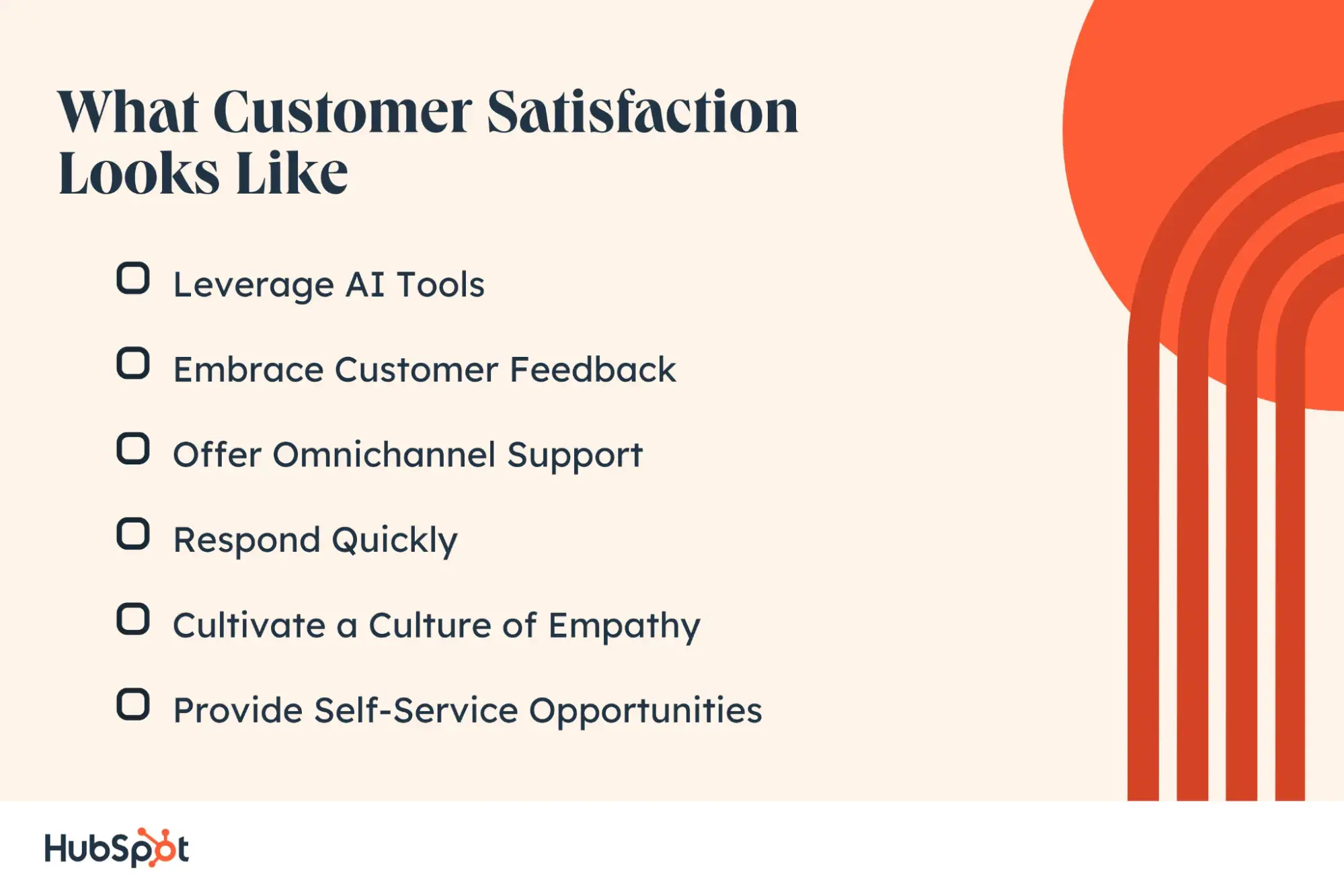
1. Leverage AI Tools
Artificial intelligence (AI) tools can elevate the customer experience by saving time for both reps and customers. AI chatbots can resolve routine customer inquiries almost instantly, and AI assistant tools can help streamline reps' workflows with intelligent responses and automated actions.
As a customer, I prefer to send a quick message to an AI chatbot that can resolve my issue over spending the extra time getting in touch with someone. In general, I believe AI tools have the potential to revolutionize customer satisfaction, setting the bar much higher with reduced response times and super-powered agent capabilities.
However, I think it's crucial that we remember the human element of customer experience. Maybe AI will prove me wrong one day, but for now, there is no substitute for the empathy and genuine human interaction that underscore the highest level of CX.
According to HubSpot’s 2024 State of Customer Service Report, 92% of CRM leaders say AI has reduced customer service response times. Reducing customer service response times is a massive factor in improving the customer experience.
No one wants to be left hanging on hold when a bot can update their billing address automatically instead. Consider implementing AI tools to bring your organization into the modern era of customer satisfaction, but don’t lose sight of what makes for the highest level of customer interactions — people!
2. Embrace Customer Feedback
In my experience, there's no better source of insight than the customers themselves. I believe actively listening to customer feedback is the most direct path to understanding and meeting their needs. Feedback is the fuel that drives customer satisfaction, so you should both collect it and analyze it carefully.
The most iconic customer feedback metric is the NPS score, which stands for Net Promoter Score. It's a customer satisfaction benchmark that measures how likely your customers are to recommend your business to a friend.
NPS is excellent for gaining an understanding of overall customer satisfaction. However, if you’re looking to drill down more specifically into what your customers love and what you could do to make them even happier, then you’ll need to implement more in-depth customer satisfaction surveys.
Not sure where to start? Here are 23 excellent customer satisfaction survey examples with templates!
Pro tip: A little incentive can go a long way in gathering valuable customer feedback. Don’t be afraid to offer small perks like discounts, exclusive content, or early access to new features in exchange for feedback. It’s a worthwhile investment that will lead to happier customers and a boosted bottom line.
3. Offer Omnichannel Support
Omnichannel support means you can meet customers wherever and whenever. It’s a popular approach. In fact, 53% of customers prefer an omnichannel approach where they can access support through any platform and continue the interaction anywhere without loss of context.
As a customer, I expect to reach support via text, phone, email, chat, or social media. Anything less than an omni-\channel support experience feels frustrating and outdated.
Pro tip: Figure out what platforms your customers frequent and ensure those channels are ready at all times to respond to customer needs.
4. Respond Quickly
Time is money, and everybody wants more of both! Delivering quick responses saves customers valuable time and boosts your bottom line. Satisfied with your lightning-fast response times, customers are likely to spend more and recommend you to their friends.
Pro tip: Sometimes, it’s appropriate to prioritize challenging cases with frustrated customers over routine inquiries. Depending on the circumstances, your reps should consider responding first to high-priority cases, even if they're not at the top of the queue.
In my experience, a quick response goes a long way in cultivating satisfaction out of a potentially difficult customer experience.
5. Cultivate a Culture of Empathy
Customers want to feel like you care about them, and there is no faking it. In my opinion, empathy is the cornerstone of customer satisfaction. Everybody wins when you genuinely care about the customer’s well-being and success using your product.
Empathy in customer support is straightforward and much easier to cultivate, given daily customer contact. You should hire and train reps for the soft skills and emotional intelligence required to walk a mile in the customers’ shoes.
However, cultivating empathy isn’t just for support teams. It should be a company-wide initiative, especially for those teams without direct customer contact.
To create a customer-centric culture, I recommend beginning by gauging your internal understanding of your customers’ needs. From there, you can design culture initiatives and immersion opportunities to ensure your employees are tuned in to customer needs and challenges.
According to Qualtrics’ Employee Experience Report, 76% of consumers expect companies to understand their needs and expectations, and 62% say they feel more loyal to brands that are empathetic. Integrating empathy into the fabric of your company culture will make customer satisfaction second nature to all your teams and bolster your bottom line.
6. Provide Self-Service Opportunities
Did you know 69% of customers say they prefer to use self-service options before contacting a live representative? I’m one of them. Perhaps it has something to do with social anxiety and coming of age during the advent of search engines, but I vastly prefer to solve my issues via a knowledge base or self-service portal.
Self-service opportunities save time and make customers feel empowered and independent, which is a boon for their long-term satisfaction. When I worked in support, I closed many cases by solving customer issues and passing along relevant knowledge base articles. That allows customers to improve their knowledge and become more efficient, successful users of our product in the future.
Customer satisfaction is a long game, and providing customers with self-help and enrichment opportunities is crucial for sustained success and happiness in your organization.
Customer Satisfaction Is Essential for Business Growth
As a former support representative at HubSpot, I witnessed firsthand that customers are the lifeblood of business. I loved the impact I had on customers by offering empathy and enthusiasm when assisting them.
Satisfied customers impact more than just revenue. It struck me how a single positive interaction could transform a frustrated customer into a loyal advocate who was eager to recommend us to friends and family.
I learned that by prioritizing customer satisfaction, we were doing so much more than just problem-solving. We were forging strong customer relationships that resulted in reduced churn and increased customer lifetime value.
Looking back on my experience in HubSpot support, it’s clear how every interaction is a priceless opportunity to create a lasting bond between the company and the customer.
The built-in feedback dashboard in HubSpot’s Customer Service Software can help you gain insights to make your customers happy. You can use this tool to onboard new customers, collect, organize, and respond to customer requests, and improve customer satisfaction from one dashboard.
Editor's note: This post was originally published in October 2017 and has been updated for comprehensiveness.
Customer Satisfaction
.png?width=112&height=112&name=Image%20Hackathon%20%E2%80%93%20Horizontal%20(24).png)

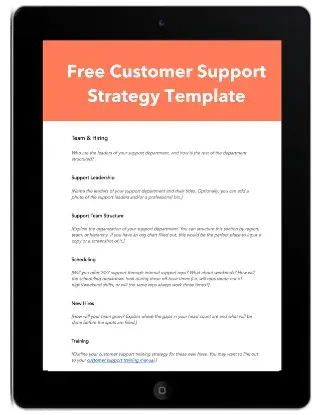
.webp)
![Big Brands That Lost Customers' Satisfaction [Where CX Went Wrong + Data]](https://53.fs1.hubspotusercontent-na1.net/hubfs/53/companies%20that%20lost%20customers_featured.png)


![23 Excellent Customer Satisfaction Survey Examples [+ Templates]](https://53.fs1.hubspotusercontent-na1.net/hubfs/53/customer-satisfaction-survey-example_0.webp)

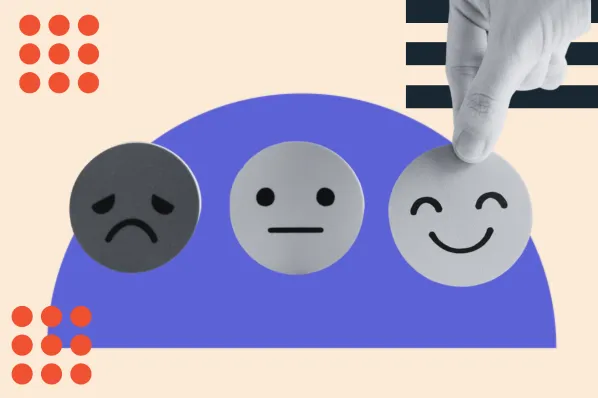


![How To Design Customer Satisfaction Surveys That Get Results [+ Templates]](https://53.fs1.hubspotusercontent-na1.net/hubfs/53/customersatisfactionsurvey.webp)
